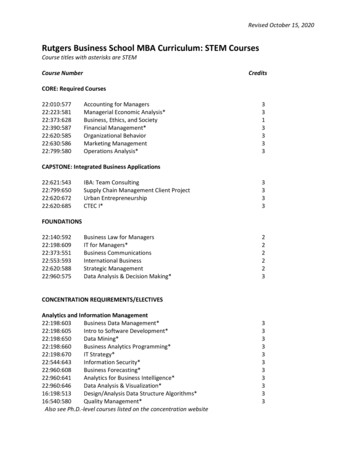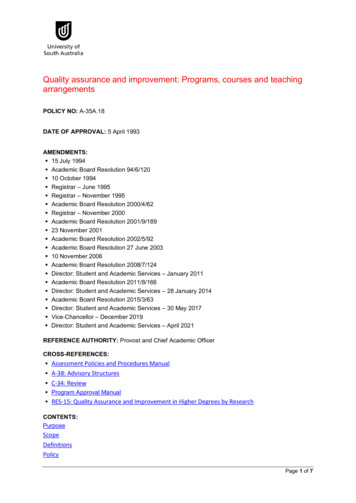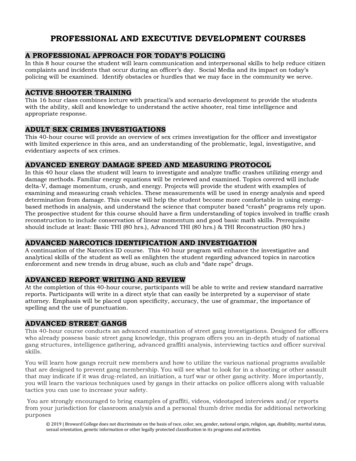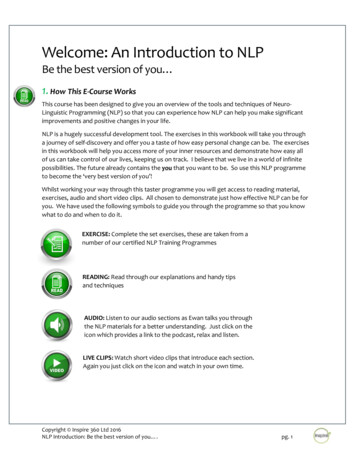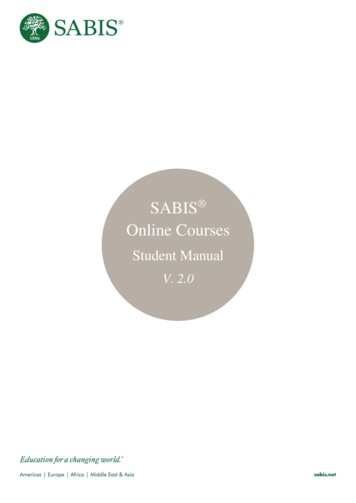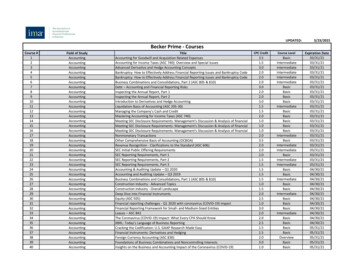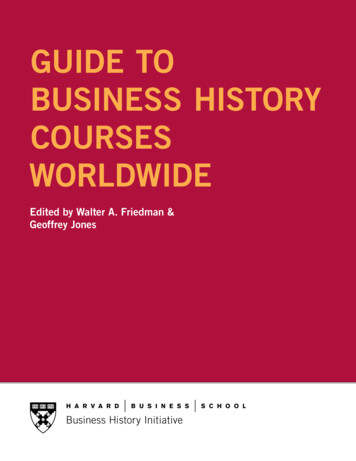
Transcription
Guide toBusiness HistoryCoursesWorldwideEdited by Walter A. Friedman &Geoffrey Jones
Guide toBusiness HistoryCoursesWorldwideEdited by Walter A. Friedman and Geoffrey Jones President and Fellows of Harvard College1
Table of Contents1. Introduction2. Guide to Business History CoursesCompiled by Walter Friedman and Shaun S. Nichols, HarvardBusiness School3. Index of Syllabi4. Syllabus Collection5. Acknowledgments2
IntroductionThis e-book was put together as part of a conference held by the Business History Initiative atHarvard Business School on June 28, 2012. The Initiative, which was created by the school‘sdean, Nitin Nohria, in December 2011, both celebrates the School‘s long tradition in the subject,and provides the institutional basis to promote and expand the impact of the field. (Informationabout the Initiative can be found at the website http://www.hbs.edu/businesshistory.) Theproceedings of the conference are available in another electronic publication, ―TeachingBusiness History: Insights and Debates.‖ This guide to courses was intended to supplement thesessions of the conference. It includes 197 syllabi. All of the instructors have given theirpermission to have their course syllabi distributed in this volume. Please be advised that thereport is very long at 1,243 pages and you may not want to print it. We hope readers will findthis guide helpful as they assemble and teach courses in the field of business history.3
Guide to Business History CoursesCompiled by Walter Friedman and Shaun S. Nichols, HarvardBusiness SchoolThe original goal of this guide was, in a sense, to conduct a global census of who was teachingbusiness history, what they were teaching, and to whom (business students? humanities students?social scientists? etc.) It was not intended to include every course, but to provide a large sample.We decided early on that, for the purposes of our project, ―business history‖ would includehistories of finance, management, and capitalism more broadly. To keep our project manageable,however, we also decided to exclude many economic history courses, histories with too narrow atemporal framework (e.g., ―Business in the Great Depression‖), as well as most syllabi older than2008. We also wanted to insure that we remained sensitive to the diversity of business historyapproaches around the world.It is difficult to condense some 200 classes into any neat typology. Nonetheless, it seemsclear that professors must make important choices in the forming of a class, and these choices donot entirely resist categorization. For the purpose of synthesis, it might be useful to distill fourkey issues: methodology, geographic scope, audience, and purpose.Methodology. Methodologically, we found four common approaches to business historyacross the globe. First, we see traditional, managerial, firm-centered approaches. These coursesare especially popular in the United States, and tend to be organized around issues such as theevolution of the firm, business-state relations, and the changes wrought by an increasinglyglobalized economy.11For a few exemplary syllabi, see Maria Inés Barbero and Andrea Lluch‘s ―Seminario de Historia de Empresas[Seminar in Business History]‖ (San Andrés), Andrew Thomson‘s ―Business History‖ (Schulich, York), BenjaminWaterhouse‘s ―The History of American Business‖ (UNC), Sharon Murphy‘s ―American Business History‖(Providence), Pierre van der Eng‘s ―Development of Modern Business‖ (Australian National), and Franco Amatoriand Veronica Binda‘s ―Business History‖ (Bocconi).4
Second, we found an increasing number of courses organized around the history ofcapitalism itself—taken as a social, economic, cultural, and political phenomenon. These coursestend to be more methodologically eclectic and interdisciplinary, ranging broadly from labor tocultural to economic history.2 Yet this division between ―business history‖ and the ―history ofcapitalism‖ is not necessarily clear: we also found cases in which professors who taught―business history‖ only two years ago had re-branded the same class as the ―history ofcapitalism‖ without any real change in pedagogy or methodology.Third, many courses remain in the traditional sectors of financial and banking history.These courses also tend to have significant amounts of legal, political, and commercial history. 3Finally, we found a large number of courses structured around specific underlying issues in thehistory of business. ―Globalization,‖ for instance, is popular (especially outside the UnitedStates) as a prism through which to view business history—or vice versa.4 We also found anumber of courses structured around the evolution of ―Technology‖ or simply ―Innovation‖ more2See Sven Beckert, ―History of American Capitalism,‖ ―History of European Capitalism,‖ and Sven Beckert andChristine Desan‘s ―The Political Economy of Modern Capitalism, Research Seminar‖ (Harvard). Also see MatthiasKipping, ―Creating Global Capitalism‖ (Schulich, York); David Sicilia, ―Capitalism: How it Works,‖ ―GlobalCapitalism,‖ and ―American Capitalism: Graduate Readings in U.S. Economic and Business History‖ (UMD); SallyClarke‘s ―American Capitalism, 1865-2000: A History of Innovation and Economic Rights‖ (UT Austin); ColeenDunlavy‘s ―History of American Capitalism‖ (Wisconsin); and Judy Slinn‘s ―The Creation of Modern Capitalism‖(Oxford Brookes).3See Chris Kobrak and Joe Martin‘s ―The Canadian and American Financial Systems—Comparisons andContrasts‖ (Rotman, Toronto), James Darroch‘s ―The Co-evolution of Financial Markets and Institutions,‖ DavidMoss‘s ―Creating the Modern Financial System‖ (HBS, Harvard), Christine Desan‘s ―The Legal Architecture ofGlobalization: The History & Institutional Development of Money and Finance‖ (Harvard), Richard Sylla‘s ―TheDevelopment of Financial Institutions and Markets (NYU), Per Hansen‘s ―Finance and Financial Institutions inSociety‖ (Copenhagen), and John Turner‘s ―Corporate Finance‖ (Queen‘s, Belfast).4See Maria Inés Barbero and Andrea Lluch‘s ―Seminar in Business History‖ (San Andrés); Marc J. Stern‘s―Capitalism, Socialism, and Globalization‖ (Bentley); E. Brake, F. Bishara, R. Druckman, and R. Penner‘s―Globalization: A Hitchhikers Guide to World Capitalism‖ (Duke); Franco Amatori and Francesca Polese‘s―Comparative Business History: Competition and Globalization‖ (Bocconi); Espen Storli‘s ―International EconomicContemporary History‖ (Trondheim); and Paloma Fernández‘s ―Family Businesses, Innovation and Globalization inthe World‖ and ―Globalization and Businesses in the World in a long-term Perspective‖ (Barcelona).5
broadly.5 Many traditional business history courses also have significant readings dedicated totechnological change and innovation. Another common issue we came across was ―financialcrises‖ or ―capitalist crises‖ more broadly. Indeed, courses on the history of ―financial crises‖seem to be nearly as common as general courses on the history of finance.6 With the 2008recession still a not-too-distant memory, we came across many of these courses all around theworld.Geographic scope. Another significant fault line across courses is geographic scope.Although within the United States, national business history remains popular, many othercourses (especially in Europe and Japan) take a more comparative approach. Many professors,for example, using Thomas McCraw‘s Creating Modern Capitalism, employ a comparativeperspective across Britain, Germany, the United States, and Japan. Most Canadian businesshistory courses traverse the United States and Canada. In Japan, many professors offer businesshistory as a two-semester series with one half focusing on Japan and the other half focusing on―foreign‖ or ―western‖ business history.Others courses take a more dedicatedly global, regional, or international orientation—especially in fields like management, banking, commerce, and globalization. For example, aDuke University course taught by four advanced graduate students entitled ―Globalization: AHitchhikers Guide to World Capitalism‖ traces the global development of capitalism frommedieval-era Muslim merchants to the present. Alison Frank‘s course on ―Commodities inInternational History‖ dedicates weekly readings to specific commodities (sugar, tobacco,cocaine, etc.), following them both globally and ―across the socio-economic spectrum.‖5For a few examples, see Richard John‘s course, ―The History of American Capitalism since 1760: Business,Technology, and the State‖ (Columbia), Steven Usselman‘s ―Technology and the Shaping of America‖ (GeorgiaTech), Eugene Choi‘s ―Business History of Technology‖ (Ritsumeikan University), Sally Clarke‘s ―Innovation inthe US Economy‖ (Texas), Colleen Dunlavy‘s ―History of American Technology‖ (Wisconsin), and Pamela Laird‘s―The Cultural Politics of Progress: Technologies, Societies, & Cultures.‖ (Colorado).6See Lawrence Summers‘ ―Crisis Economics: History and Evaluation of the Policy Response to the GreatRecession‖ (Harvard), Charles W. Calomiris‘s ―The History of Financial Crises and Responses to Them‖(Columbia), Julia Ott‘s ―Wall Street in Crisis: A Genealogy‖ (New School), Robert Wright‘s ―Financial Crises: AGlobal Perspective‖ (Augustana), Per H. Hansen, and Alfred Reckendrees‘s ―The Recent Financial Crisis and ItsPredecessors: Crisis, Contagion, Political and Corporate Response‖ (Copenhagen), as well as Youssef Cassis andLászló Bruszt‘s ―Financial Crises: Theoretical Approaches and History‖ (European University).6
Additionally, outside of the United States, there is no lack of courses taught in an internationalrather than national perspective.Although less common, we also found a handful of courses approaching businessthematically. African American business history courses, for example, not only used case studiesto answer larger questions about the history of business, they also tended to focus on legal andentrepreneurial issues specific to the history of African American business.Audience and purpose. In the areas of audience and purpose, we again found divergence.A number of courses are geared towards business students. Generally, these courses emphasizethe ways in which history can be used to aid in the making of strategic choices today, and can befound worldwide. In Europe and America, however, these courses frequently use historical casestudies (analyzing the strategic choices and consequences of a particular company or industry),whereas in Latin America, these courses seem more geared towards political issues andgovernment-business relations.7History departments were another frequent home for business history courses. Thesecourses are actuated by questions such as how ―American entrepreneurs, CEOs, middlemanagers, shop-floor laborers, professionals, and policymakers negotiated, contested, andultimately shaped the complex world of modern business‖ (Waterhouse) or how the UnitedStates turned ―turned from a relatively minor outpost of the Atlantic economy to the powerhouseof the world economy‖ (Beckert) or how the relationship between entrepreneurs, the state, andinnovation evolved over time (Clarke).Other business history courses can be found in government schools, sociology, andeconomics departments. Although not exclusively, these courses also tended to have what mightbe called a more ―policy-oriented‖ purpose. For instance, many courses on the history offinancial courses were explicitly oriented towards making students think more critically aboutpolicy formation and evaluation.7For a few examples of business history courses geared to strategy, see Maria Inés Barbero‘s ―Argentine BusinessCases: Contexts and Strategies in the 20th Century‖ (San Andrés), Andrea Lluch‘s ―Entrepreneurship andCapitalism in Latin America‖ (San Andrés), Carlos Dávila‘s ―Entrepreneurship and Management in Colombia‖(Univ. de los Andes), as well as Joe Martin‘s ―Using History to Make Strategic Choices‖ (Rotman, Toronto), andChris McKenna‘s ―General Management‖ (Saïd, Oxford).7
Index of SyllabiThe following is an index of the courses we have collected along with a very brief description for each course. The―syllabus‖ link refers to where you can find a copy of the complete syllabus. Also keep in mind that some syllabihave had minor alterations made to them in the interest of space. Plagiarism policies, general university policies, andinstructor biographies are the most common cuts. All syllabi were reformatted in a common font and font size.(A)THE ed StatesASIAi. inSwedenSwitzerlandx. United Kingdom8
THE AMERICASARGENTINAUniversidad de San Andrés; Victoria, Buenos Aires, ArgentinaBarbero, Maria Inés & Lluch, AndreasyllabusSeminario De Historia De Empresas[Seminar in Business History] (2010)―[translated roughly] Over the past hundred years Argentine companies have gonethrough various critical stages, sometimes with success, other times without the ability tosurvive the macroeconomic instability and frequent changes in the rules of the game.The seminar intends to analyze performance and strategies of Argentine firms throughoutdifferent stages of the economic history of the 20th century, with the emphasis on theglobal contexts in which they operated and the specificities of the local scene. The courseis organized on the basis of the three major phases of globalization identifiable betweenlate 19th century and the beginning of the 21st century. The first corresponds to the1850c.-1929 period, in which took place the first global economy. The second takes placebetween 1929 and 1979, and includes the disintegration of the first global economy(1929-1950) and the beginning of the second global economy (1950-1979). The third, inwhich we are immersed, is the recreation of global capitalism since the early 1980s (thesecond global economy). The methodology will be based on the analysis a
Moss¶s ³Creating the Modern Financial System (HBS, Harvard), Christine Desan¶s ³The Legal Architecture of Globalization: The History & Institutional Development of Money and Finance (Harvard), Richard Sylla¶s ³The Development of Financial Institutions and Markets (NYU), Per Hansen¶s ³Finance and Financial Institutions in Society (Copenhagen), and John Turner¶s ³Corporate Finance .

